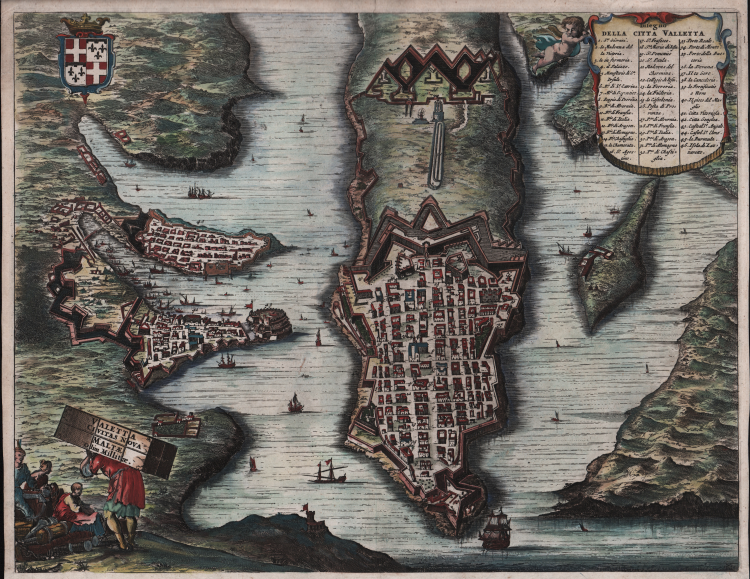




| Reference: | MMS1624.1 |
| Author | Olfert DAPPER |
| Year: | 1676 |
| Zone: | Malta |
| Printed: | Amsterdam |
| Measures: | 365 x 565 mm |



| Reference: | MMS1624.1 |
| Author | Olfert DAPPER |
| Year: | 1676 |
| Zone: | Malta |
| Printed: | Amsterdam |
| Measures: | 365 x 565 mm |
Magnificent bird's-eye plan of the harbor and city of Valletta seen from the northwest. Beautifully engraved with a unique pictorial title cartouche, ships, a coat of arms and a decorative key locating 46 sites within the city. Seen from the northwest, the city is richly detailed, although likely arranged more geometrically than in reality. Surrounding cities of Senglea and Vittoriosa, as well as Fort Ricasoli, are also shown to the left of the capital. A figured title cartouche in the lower left shows a group of men, one carrying a trunk on his back bearing the title. The surrounding waters are filled with decorative ships, and a French coat of arms is drawn in the upper left corner to indicate France's colonial control of the region.
The map is taken from the Naukeurige beschrijvinge der Afrikaensche gewesten van Egypten, Barbaryen, Lybien, Biledulgerid, Negroslant, Guinea, Ethiopiën, Abyssinie: vertoont in de benamingen, grenspalen, revieren, steden, gewassen, dieren, zeeden, drachten, talen, rijkdommen, godsdiensten en heerschappyen. ... published in Amsterdam, by Jacob van Meurs, 1676.
The Amsterdam author Olfert Dapper (1636-1689) was celebrated by his contemporaries for his descriptions of far away lands. He started his writing career with a description of Amsterdam, the city where he lived all his life. His description of the entire continent of Africa and its islands was first published in 1668, which was still early in his career. It is now accepted as his best work and was translated into German and English in 1670, and into French in 1686. The second edition, appeared in 1676 and was much enlarged.
Dapper's attention was mainly drawn to the Islamic North of Africa, with extensive and thorough descriptions of the area between Morocco and Egypt (with a magnificent illustration of pyramids) and the Ethiopian Empire (Abyssinia). Its maps of the whole of Africa, Egypt and Ethiopia include the Arabian Peninsula as far as the Persian Gulf and provide a detailed display of the Red Sea.
Dapper's interdisciplinary approach was innovative. He compiled his description of Africa from various sources, including unpublished Dutch reports and eye-witness accounts, most of them now lost or scarce, which makes this early work on Africa of enduring value for the history of the continent.
Copperplate, trimmed at the borderline or with thin margins (as issued), fine later hand colour, very good condition.
Olfert DAPPER (Amsterdam 1636 - 1689)
|
Olfert Dapper (January 1636 – 29 December 1689) was a Dutch physician and writer who wrote books about world history and geography although he never travelled outside the Netherlands. Olfert Dapper was born in early 1636 in the Jordaan in Amsterdam. On 6 January 1636, he was baptized in the Lutheran church in Amsterdam. In 1663 wrote a book on the history of Amsterdam. His Description of Africa (1668) is a key text for African studies. His book is one of the most authoritative 17th-century accounts on Africa published in Dutch. Translations appeared in English, French, and German. Dapper never travelled outside the Netherlands but used reports by Jesuit missionaries and Dutch explorers. Within a few years, he published about China, India, Persia, Georgia and Arabia. His books became well known in his own time. The fine plates include views of Algiers, Benin, Cairo, Cape Town, Valletta, Marrakesh, St. Helena, Tangier, Tripoli and Tunis, as well as animals and plants.
Dapper was buried on 29 December 1689 in Amsterdam.
|
Olfert DAPPER (Amsterdam 1636 - 1689)
|
Olfert Dapper (January 1636 – 29 December 1689) was a Dutch physician and writer who wrote books about world history and geography although he never travelled outside the Netherlands. Olfert Dapper was born in early 1636 in the Jordaan in Amsterdam. On 6 January 1636, he was baptized in the Lutheran church in Amsterdam. In 1663 wrote a book on the history of Amsterdam. His Description of Africa (1668) is a key text for African studies. His book is one of the most authoritative 17th-century accounts on Africa published in Dutch. Translations appeared in English, French, and German. Dapper never travelled outside the Netherlands but used reports by Jesuit missionaries and Dutch explorers. Within a few years, he published about China, India, Persia, Georgia and Arabia. His books became well known in his own time. The fine plates include views of Algiers, Benin, Cairo, Cape Town, Valletta, Marrakesh, St. Helena, Tangier, Tripoli and Tunis, as well as animals and plants.
Dapper was buried on 29 December 1689 in Amsterdam.
|